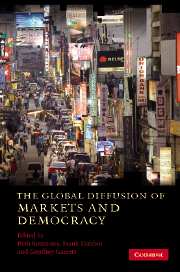Book contents
- Frontmatter
- Contents
- List of appendixes
- List of figures
- List of tables
- Notes on contributors
- Acknowledgements
- 1 Introduction: the diffusion of liberalization
- 2 Tax policy in an era of internationalization: an assessment of a conditional diffusion model of the spread of neoliberalism
- 3 The decision to privatize: economists and the construction of ideas and policies
- 4 The international diffusion of public sector downsizing: network emulation and theory-driven learning
- 5 Global ideology and voter sentiment as determinants of international financial liberalization
- 6 Competing for capital: the diffusion of bilateral investment treaties, 1960–2000
- 7 Diffusion and the spread of democratic institutions
- 8 World society and human rights: an event history analysis of the Convention on the Elimination of All Forms of Discrimination against Women
- 9 Conclusion
- Index
- References
7 - Diffusion and the spread of democratic institutions
Published online by Cambridge University Press: 04 August 2010
- Frontmatter
- Contents
- List of appendixes
- List of figures
- List of tables
- Notes on contributors
- Acknowledgements
- 1 Introduction: the diffusion of liberalization
- 2 Tax policy in an era of internationalization: an assessment of a conditional diffusion model of the spread of neoliberalism
- 3 The decision to privatize: economists and the construction of ideas and policies
- 4 The international diffusion of public sector downsizing: network emulation and theory-driven learning
- 5 Global ideology and voter sentiment as determinants of international financial liberalization
- 6 Competing for capital: the diffusion of bilateral investment treaties, 1960–2000
- 7 Diffusion and the spread of democratic institutions
- 8 World society and human rights: an event history analysis of the Convention on the Elimination of All Forms of Discrimination against Women
- 9 Conclusion
- Index
- References
Summary
Democracy and democratization in time and space
In 1989, a series of popular protests in the German Democratic Republic (GDR) forced the resignation of Erich Honecker and the fall of the wall separating the East German capital from West Berlin. The speed of the organization of the opposition and the fall of the regime surprised many Western observers. Although dissatisfaction with economic and political conditions was assumed to be widespread in the GDR, the repressive character of the state made opposition very costly. Yet, it grew. The dramatic increase in the open opposition to the regime stemmed in part from changes in external conditions, as liberalization in other Eastern European states facilitated organizing protest in the GDR. The Soviet leader Mikhail Gorbachev had begun to let the countries in the Soviet bloc deal more independently with their own internal and foreign politics. The declining Soviet commitment to the Honecker regime lowered the perceived costs of protest, as a military response and invasion became less likely. Neighboring countries such as Hungary had initiated moves toward open, competitive elections. Since Hungary was a popular travel destination for East Germans, the opportunities for emigration to the German Federal Republic through neighboring states presented a huge problem to the regime in East Berlin. By the middle of 1989, many East Germans were heading to Hungary on “vacation” with all their worldly possessions, having locked one last time their East German apartments.
- Type
- Chapter
- Information
- The Global Diffusion of Markets and Democracy , pp. 261 - 302Publisher: Cambridge University PressPrint publication year: 2008
References
- 10
- Cited by

